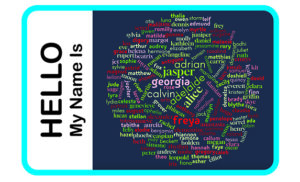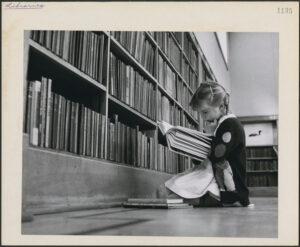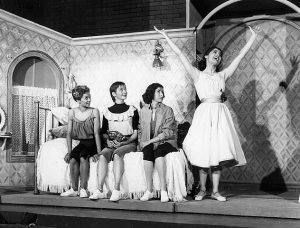Posts by Jeanne Kisacky
Naming characters is my least favorite part of writing. A character’s name imparts more than just a moniker by which to differentiate actors in a plot. Names are powerful—they provide limits and possibilities to what the character might be or do. For me, the wrong name for a character throws things off in the writing. A character that has not been given the right name misbehaves. Beatrice would not speak the same way that Susan would. Ernest would choose different clothes from Roderick. Until I find the right name for a character, they don’t willingly occupy their role within the larger story.
While clearly I tend to overthink things, these expectations are extensively influenced by stereotypes and preconceptions. The connections we make when we hear someone’s name are as instantaneous, as deep-rooted, and as difficult to shift as first impressions. Getting them right is worth a little extra time and consideration.
I’m not going to tell you how to choose or derive a name—there are numbers of name generator tools on-line. I’m going to try to highlight the complexity and variety of ways in which a name can influence first impressions to help provide you with ways to assess what name best fits your character and your story.
The Power of Names:
Names create expectations, not just of the person’s individual characteristics, but also of their background:
Read More
A couple months ago I stumbled across a draft of a novel manuscript I’d written many years ago. It was a story that had come to me all at once, and that (unlike all my other works in progress) had been a joy to write because it had flowed and it had taken my mind off some hard realities during a difficult time of life. I had finished the draft and then put it away.
In the spring of this year I was in another hard reality period of life and I don’t know if it was chance or fate that I came across that long-neglected draft but I sat down to read it. I still loved the story, and I could see clear as day how to refine it and make it stronger. I could also see how much of the first draft was just not needed. It was crowded with things I wrote while trying to get the draft down, but which didn’t contribute to the plot or which weren’t critical to the characters’ story arcs. They were all going to hit the cutting room floor.
Wouldn’t it be nice, I thought, if I could write a draft without all that dross and not spend all the extra time putting it in only to take it back out? The years that had passed since writing it gave me a gift—enough distance from the original writing of the story to make evident some lazy writing habits of mine that had contributed to the unnecessary passages.
I imagine every writer has their own writerly tics–the things they write when they are really searching for the next salient plot point, trying to nail down a setting, or figure out the character. Here’s my short list of my own top five lazy writing habits—the categories of things that didn’t need to get written and which certainly didn’t need to remain in the next draft. My hope is this list will give other readers a way to see their own literary surplusage.
Too much non-resonating detail.
That early draft had an incredible amount of detail that was just not needed and which actually distracted from the flow. When the characters went out for a meal, I described every dish in sequence. The waiter introduced himself and got a full description even though he was not relevant to the conversation or the plot. I devoted a full sentence to the boot tray that sat at the entrance to a house, described each individual piece of furniture within a room, and named every piece of equipment in a woodshop. In the best light, these details were setting a scene, but they were not part of the story.
Anyone who has eaten out understands that there are wait staff. Unless that person plays a role in the story they don’t need to be named or described. Anyone who has lived in sloppy climates knows what boot racks are for. Unless that boot rack was a murder weapon or would change a character’s life, it did not need a whole sentence.
Detail can be critical to a clearly told and understood story, but the details must matter, and they must create a story flow. Details that provide a relevant piece of information are […]
Read MoreEvery story is told from a point of view (POV). Who is telling the story determines the story that can be told, because it determines what the reader can know about actions, characters, events, thoughts, and motivations. The more limited the viewpoint, the more limited the reader’s access to information and the more personalized that information is. The more diffuse the viewpoint, the more comprehensive the reader’s access to information, but also the less personalized that information is. If you want to write a sweeping historical saga, a close first person viewpoint might not be the easiest. If you want to write an intimate story of personal transformation, distant third person will make your work harder.
What POV should your story be in? If the story is told through more than one character’s viewpoint, which character should be telling which scenes? Asking these simple questions can provide a strategy for editing and refining as well as drafting a story.
I am revising a work in progress from distant third person to close third person POV. I’ve already written a post about how writing in closer third person breathed more life into the characters and how that changed the story. In my revisions, I also discovered that sometimes the problems with a chapter or a scene stemmed not from whether it was ‘close enough’ third person, but whether it was being told by the wrong character. I solved several of those problem scenes by rewriting them from a different character’s POV.
The first step in that revision was choosing which character should be telling the story or scene. Particularly for complex scenes with many characters and many interwoven plot details, the best POV character was not always obvious. Each knew pieces of the story puzzle, but not all; each was there for their own reason, but didn’t know why some of the others were there.
I developed two questions that helped me determine which character provides the best POV for a scene. One question is about the emotional impact of the scene, the other is about the information needed to understand the scene.
While it’s obvious that telling the scene through the most emotionally affected character keeps the stakes high, if that character can’t tell the reader the information necessary to understand what’s going on in the story, then the author has to find another way to impart that information. Those ‘other ways’ are often places where the writing breaks down. The necessary information is offered to the reader through head hopping (temporary shifts in POV), through often intrusive narrative or […]
Read MoreTo say that I am a pantser is not to say that I dislike organization, or that I don’t have an idea of where my story is going. I am a pantser in part because I have never found a tool that lets me effectively organize all the story elements—characters, locations, events, story arcs, and narrative scene sequence. In essence, I start writing by the seat of my pants when all my half-blown attempts at organizing the story fall short. Then I give up and just start getting the scenes down before they leave me.
I have tried many tools and strategies, including:
Most of these tools tracked one or two narrative elements effectively, but then I had to track other elements using secondary organizational strategies. For example, a timeline app provided a clear temporal sequence, but tracking characters through the various events was difficult. When I decided to tell a story in non-chronological sequence, I was back to post-it notes in addition to the timeline app. Similarly, mindmap apps provided a good way to map scenes and relationships between them, but keeping the events in correct temporal sequence proved onerous.
This screenshot shows a mindmap for one of my stories that tracks POV characters (box colors), events (shaded boxes), relationships between events (lines between boxes), and narrative sequence (outline boxes), but chronology is inexact, and character locations had to be tracked off screen.
What am I trying to track that has defied all of these strategies? Basic story elements:
These are narrative elements that all writers have to manage, but I never seemed to find a workable strategy until I heard about Aeon Timeline. This app, built for project management as well as writing projects, combines a timeline; a spreadsheet; a mindmap; a database of persons, places, and events; the relationships between them (who did what where); a subway diagram to visualize those relationships; and the ability to track themes and even story arcs. Each of the elements (persons, events, locations) can be color-coded. This is the first app that meets the majority of my organizational requirements within the same package. The feature that really won me over was ‘narrative view,’ which provides the ability to drag timeline events into a non-linear narrative scene sequence that can be viewed either as an outline or a series of ‘cards’.
As an added bonus, once everything is all neat and tidily organized, Aeon Timeline can sync with Scrivener or Ulysses to create a scene ‘list’ ready for you to fill in the story. For writers who don’t mind working on-line and can handle a complex application, Aeon Timeline provides a powerful tool.
Some Features:
Read More
Lately I have been obsessed with the quote (typically wrongfully attributed to Albert Einstein) that “insanity is doing the same thing over and over again and expecting different results.” By this definition, I’m bonkers and have been for quite awhile. I suspect a significant proportion of writers would count themselves in that same category.
I write every day. Sometimes for minutes, sometimes for hours. Always with the hope that my fingers on the keyboard will produce brilliant prose that is well plotted, action-packed, full of micro-tension, and emotionally rewarding. And every day I write passages that aren’t.
That adds up to a lot of days accumulating a lot of unsatisfactory results while expecting better. And yet I keep at it.
It is significant to this struggle that the above quote is also linked to addiction therapy, which defines a repetitive behavior (even non-substance behaviors) as an addiction when it is a misuse–when the repeated actions create harmful effects. Should writing be considered an addictive behavior? If so, what is the harm in writing?
For me, the harm is that sitting at the computer and judging my words creates a sense of inadequacy, the feeling that the imperfections of my daily writing mean that I am not up to the task of making the words match the story I want to write. The focus is on what I write, not the process.
Admittedly some days are better than others. Some days I can get just the right tone or dialogue for at least a scene or two. Other days I stare at the screen in frustration, sometimes even deleting passages. This is when that quote starts to whisper bad tidings in my ear, suggesting that what I call perseverance is really just living in a made-up land of crazy.
But every once in a while, something clicks and the characters take over and the story flows, carrying me along. Hours pass. Magical, joyous hours during which I experience the writing as if it commands me, not the reverse. Invariably, the passages I write during those moments of flow are keepers. Often they form the lens by which I learn how to take the writing I did on other days and transform it from dreck into tolerable, sometimes maybe even good prose.
I can’t control when those good days hit. Can’t schedule them in. (If I could, there would be a lot more of them). But I have noticed a pattern.
Read MoreDo you have an unfinished writing project that you had to set aside before it was finished? Maybe life events intervened. Maybe you got stuck and shifted to a different project. Maybe you just decided to wait for another year when daily existence didn’t suck the life and soul out of your creative energy. Do you think about whether or not to pick back up with that abandoned project and try to finish it? Restarting an unfinished project can be deceptively challenging, involving far more than simply writing the next scene. If the project has been dormant for a while, there’s a good chance that the story has grown ‘cold.’ You can’t remember where the plot was heading. The characters have lost their vivid presence in your mind and feel hollow. Or maybe you are a different writer now than you were before you had to take a break, and you worry that you just can’t match the tone.
Because of a variable schedule on my day job, my writing time comes in fits and starts and I’ve had to restart cold projects on a regular and repeated basis. Here is the process I go through to get myself back ‘into’ the story and some suggestions and strategies for how to revive a cold project and finish it.
First – a warning: When you set your expectations and your goals for the project, keep your flexibility level on overload. Your intention might be straightforward–get back to the project and finish it–but there are (at least) three likely outcomes when you try to restart a cold project:
All of these are good outcomes, because they all get you past one of the biggest hurdles to getting back into any writing project–finding the emotional strength to stop looking backward and to start looking forward.
What to Do Before the Writing Break (If you can see it coming).
Sometimes, you have some advance warning that you will have to take a break from writing. Maybe you are switching jobs, or have a huge deadline coming. Maybe you are making a lifestyle change that will curtail your writing time temporarily. If this is the case, in the last days (or hours) you have left to work on it, write down where you think the story is headed. This could be a synopsis, an outline, an abbreviated story, a few critical later scenes, or even just a few lines summing up the things you think should be important for the remainder of the story. Whether you write three lines or three thousand, do not sweat the word choice, style, or punctuation for this. This is not final prose, this is a story reminder, a memory jogger. Get down the basics, the who does what, and what happens […]
Read MoreI promised to follow up my last blog post on searching for relevant grants with a post on how to write a killer proposal. Well, here we are, at my next blog post, but also in another world. One with far more questions than answers–not just about writing, but about basic life and the shape of the future. I have had too much time during shelter in place to think how useless, or even callous it would be for me to carry on as planned. Will there even be grants for writers in the future? Shouldn’t I write a post about how to navigate the now, rather than the not so certain future?
I am not a navel-gazing sort, and my only advice on how to get through the current day-to-day is simply do your best, forgive yourself often and fully, and give yourself permission to pursue what you love and want to do as often as you can. And that last piece of advice is what convinced me to carry on as planned. Because ‘permission’ to do what you love is often linked to having the financial means to do so. Perhaps it’s naïve, but I believe that when we reach the other side of this transformation there will still be opportunities worth pursuing that will require proposals and applications. Perhaps not necessarily just for writing fiction. Perhaps for getting a job. Perhaps for landing a contract. Perhaps for applying for school or education.
Whatever future we are reeling towards, knowing how to describe what you want to do convincingly, concisely, and purposely is useful. Even if you only do it as an exercise to clarify your own understanding of your goals. So here is a strategy for writing an awesome proposal, for whatever you want to pursue.
How to Write a Killer Proposal
At different points in my career some very smart, successful people (including scientists, humanities scholars, writers, and even fitness gurus) have given me advice about how to craft a good project proposal. Despite their drastically different career paths, their advice was surprisingly consistent and could essentially be boiled down to one cardinal rule and four basic pieces of information.
The Cardinal Rule: clarity of language is of more value than trying to write to impress, whether with style, wit, language, name-dropping or jargon. (Although if you can be clear and witty at the same time, then by all means do so.) A good proposal is not about how much you say, but about how well formulated what you say is.
The Four Basic Elements of a Good Proposal. Simply tell them:
For aspiring fiction writers, the typical model of professional practice is to write the whole thing then shop it around, whether to agents, publishers, or directly to readers through self-publishing and self-promotion. Payment (if any) happens long after the work is done. This means not only that income is almost always a gamble, but that critical work time is financially unsupported and often hard to come by. I work as a research administrator for scientists, who also have to do a lot of work before any payoff. The ones I know support their work largely through grants and fellowships. While grants for writers aren’t as numerous (or as lucrative) as grants for scientists, they are out there. This post is a mini-introduction to strategies for finding, selecting, and applying for money to write by. Grants for writing won’t make you rich or give you a cushy life, but they might give you the quiet time you need to finish the critical work.
Types of Funding. There are two basic types of funding available for writers—grants and residential fellowships.
To successfully apply for a grant of any variety requires three steps: A. finding grant opportunities, B. selecting among all those enticing options the opportunities that are worth your time and effort, and C. writing a killer proposal. [This post covers items A. and B.; a later blog will discuss item C.]
A. Finding Grants/Fellowships to Apply For. The internet has made searching for grants easier than ever. You can use google—try typing in ‘best writer’s retreat in x” or “grants for writers with families” and see what shows up. But there are some websites that have done some of your searching for you already. The following is a list of some useful web resources. [Readers–If you’re aware of other resources that should go on this list, please add it to the comments and I will add to this list]
Read MoreMy last post discussed nonverbal communication (gestures, expressions, posture) as a means of making scenes stronger, less repetitive, and more immediate. This blog will explore how non-verbal communication provides a means of incorporating backstory seamlessly and integrally into a work of fiction.
Backstory–where the characters have come from, what they have experienced, how they have successfully or unsuccessfully reacted to their past context–is an essential, critical, and desperately difficult element of successful storytelling. Done poorly—in ‘data dumps’, tell-all prologues, or extensive and jarring flashbacks–it pulls the reader backwards, out of the motion of the story and into a closed off past. Done well—integrated into the story–it pulls the past forward, providing clues to the way a character’s past experiences and disappointments influence present choices, actions, and mistakes.
How to integrate backstory into the story present is neither obvious nor easy. There are many writerly devices to do so—through direct communication (characters discussing the past, a character’s internal self-examination, or a narrator’s overview); through discovered records (letters, diaries, photographs), through story consequences from past actions (scars, physical injuries, institutionalization). Many of these devices require a good deal of finesse to make them a believable part of the story rather than a ‘plant.’ Would those characters really have had that conversation about the past? How convenient that the letter explaining everything was found within two pages of the conclusion. Readers are smart, and any time these writerly devices start to feel like authorial manipulation—a lazy means of communicating story information–rather than an integral part of the story, the reader loses a little faith.
Nonverbal communication–which is based on learned, repeated, or automatic responses developed from past experiences–provides a powerful story tool for connecting the present to the past in a manner that can minimize this sense of manipulation. Nonverbal communication offers immediate, visceral information to the reader; often information that the character would not willingly tell; and always information that brings the past into the present. This makes it possible for a writer to incorporate backstory as a part of the present story action, without resorting to exposition, explanation, or ‘telling.’
When a nonverbal reaction is normal, when it matches expectations, it is close to invisible. When it is unexpected or inappropriate it is glaringly visible and creates powerful story questions. Readers (and other characters in the story) instinctively understand that anomalous reactions require examination and explanation. Imagine a character whose reaction to a friend’s tear-filled apology is narrowed eyes and crossed arms. Why did she do that? The reader will typically assume that the answer lies in the character’s past–that at some point her unconventional reaction was a successful response, not an awkward one.
Emojis (which are literally a graphic alphabet of non-verbal communication) demonstrate the visceral power of inappropriate nonverbal response. Have you ever left the ‘wrong’ emoji in reaction to a text or a post? A thumbs up on a friend’s announcement of a deceased pet? A crying emoji when everyone else’s emoji is angry? Have you ever felt like you need to explain that discrepancy? Or delete it? Or edit it? That is the power of the unexpected response.
Read MoreThe last time I edited some of my work, I was dismayed to discover how many times my characters smiled, sighed, or scowled and how infrequently they used any other gestures. What, I thought, if my characters didn’t just smile, sigh, and scowl? What if they clapped hands and skipped around the room beaming? Or thumped down with a huge outrush of air, to settle in for the long tedious wait? Or leaned threateningly in towards the bully, elbows out, legs stiffened, features frozen? What if my characters could gain a much more nuanced, much more expressive range of gestures and emotions?
As I contemplated fancying up my emotional descriptions, I remembered Keith Cronin’s sage advice about pretentious words and had a reality check. Was I just getting carried away with word-love again?
Then I adopted a former stray dog, and my eyes were opened. She entered the house fully formed, with her own expectations, habits, and history. All I had to go on to figure out what she wanted or needed were her facial expressions, subvocalizations, and posture. I learned the subtle nuances of one dog ear raised, a short whine, a long whine, a big sigh. Figuring out what she was trying to ‘tell’ me had a big payoff (no messes, less chewing of items, a happy dog). This close observation became a habit, and I started watching people in everyday conversations.
Just how much of what is ‘said’ does not occur through words is astonishing. Researchers have estimated that more than half of communication (estimates range from 65% to 90% by various investigators) is non-verbal. The same words will mean different things depending on tone of voice, accompanying facial expression, posture and position of the speaker, even clothing and appearance. First impressions happen within 1/10th of a second. Or less. And they are mostly based on non-verbal communication.
There has been a lot written on non-verbal communication–even Charles Darwin wrote a book about it. (Links to a few more recent studies can be found at the end of this blog.) A lot of current research appears in psychology studies, an equally large amount appears in guides to business success, since non-verbal communication is a crucial part of making presentations and deals. I found surprisingly little written on the glorious possibilities it offers for writers of fiction. A simple summary of the characteristics of non-verbal communication reads like a checklist of strategies for improving flat scenes:
Non-verbal communication:





















